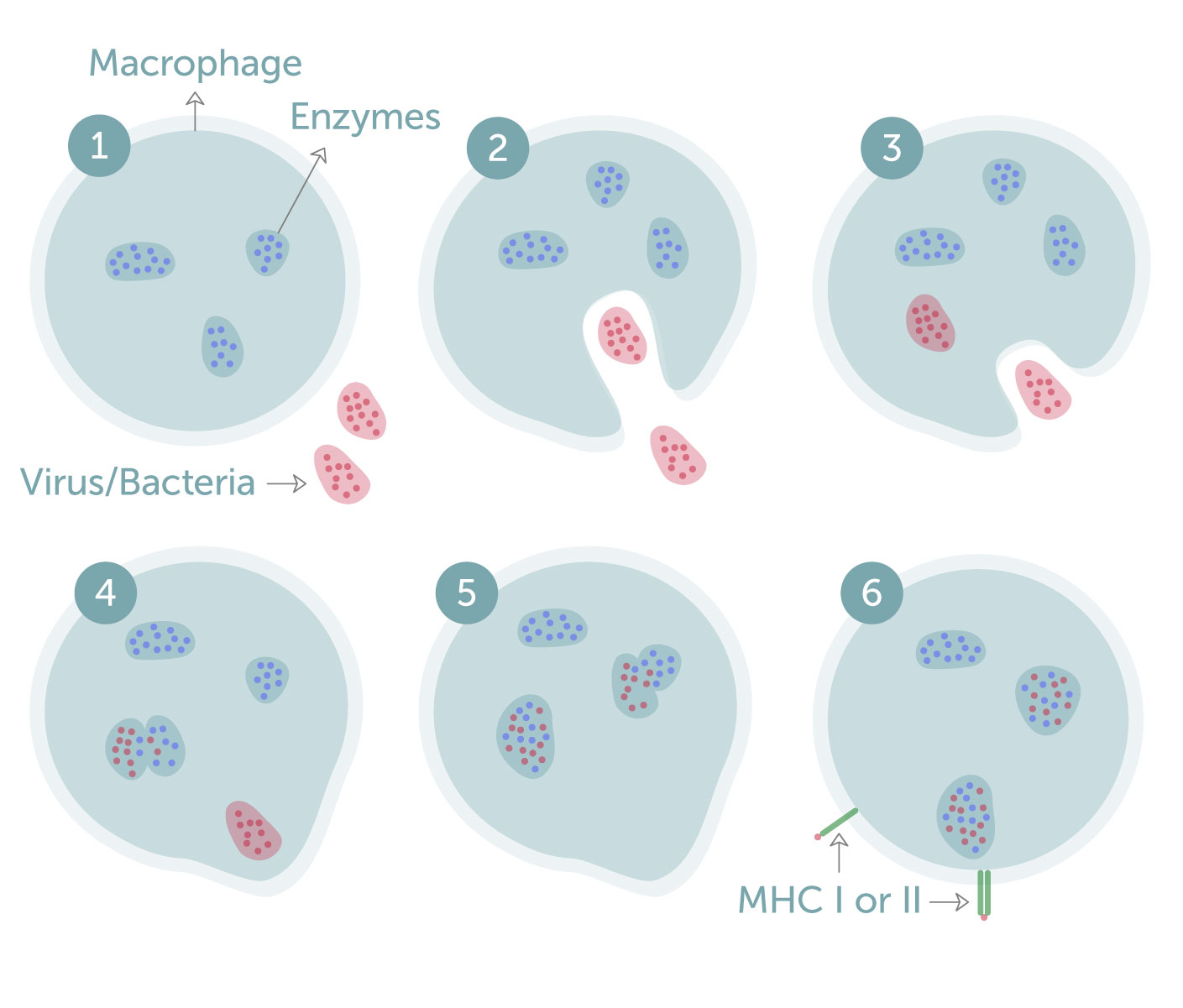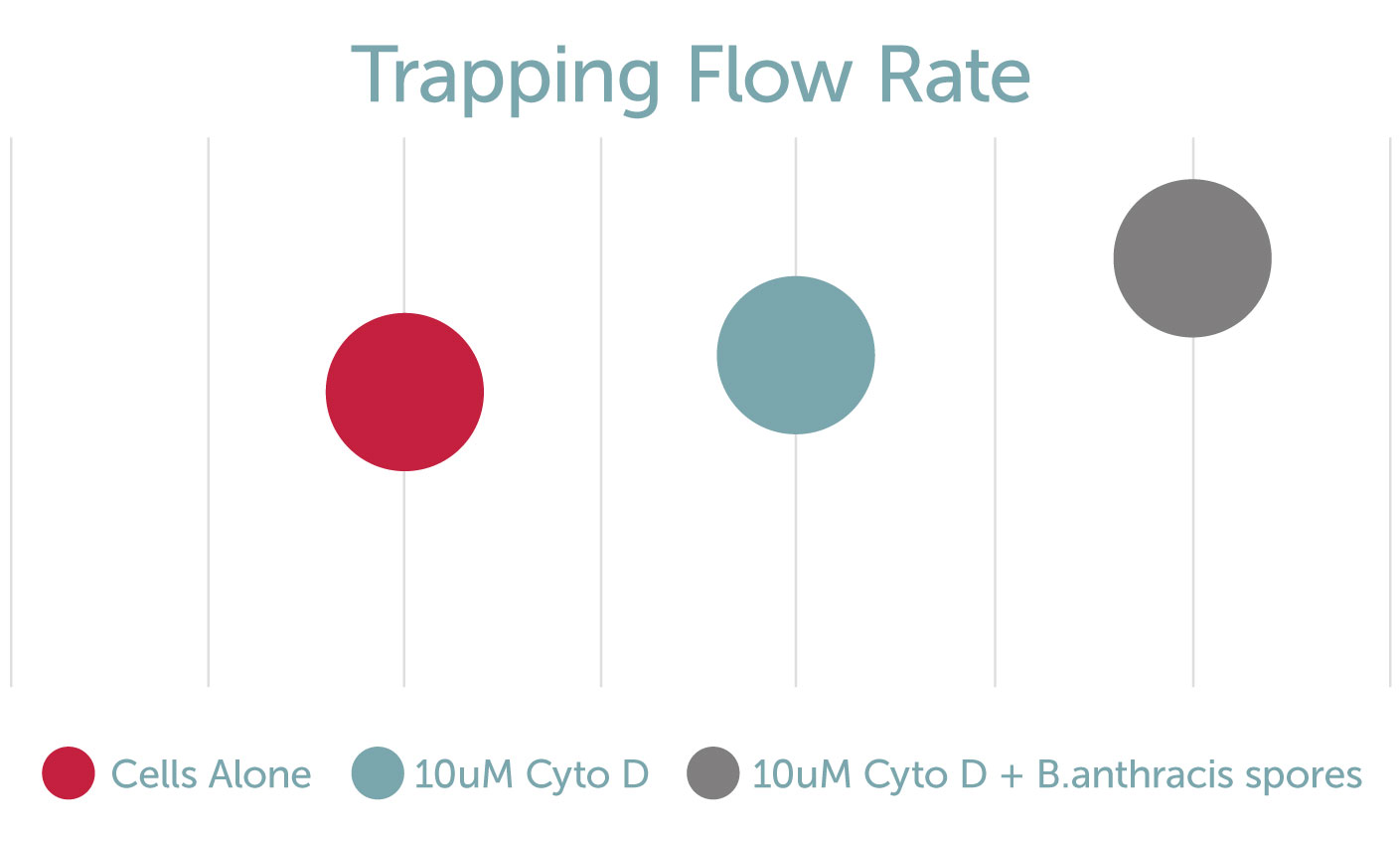Keya Rodrigues, MS, Quality Assurance Bioengineer
One of the first responders at any infection or injury site in a host are macrophages. A type of white blood cell, macrophages contribute to the innate immune system by rapidly fighting infections in a non-specific way and “teach” the adaptive immune system to react in a very antigen-specific way (humoral or cellular responses). At sites of infection or injury, cells release chemical signals that recruit resident and non-resident macrophages to the site. Once a danger signal is received, these cells can migrate by seeping through the walls of blood vessels and moving towards the infection or injury site. At the site of infection, macrophages will engulf non-commensal viruses or bacteria by phagocytosis, exposing the pathogen to degradative enzymes in the macrophage that can then break down the virus or bacteria and present the resulting antigens on the cell surface in the context of MHC I or II or expel them as non-toxic waste. (1) (2) (See Figure 1)

Figure 1. Phagocytosis in macrophages. The macrophage first engulfs the virus/bacteria (1-3), the virus/bacteria will then be broken down by the enzymes in the macrophage (4,5) and it is presented in the context of MHC I or II (6)
Human trials have been conducted on patients suffering from tumors with ex vivo educated cells (7) (8) (9). For these studies, monocytes were extracted from patients, followed by induced proliferation and differentiation into cytotoxic macrophages which were finally injected back into the host in order to hijack macrophage recruiting signals and termination of the tumor (7). More recently, studies are being carried out using macrophages as cell therapy for dilated cardiomyopathy and critical limb ischemia as targeted drug delivery vehicles (8) (9).
Research has been carried out in the past on the saliva of a sand fly vector for Leishmania major and how it aggravates leishmaniasis and may be necessary for initiation of infection. Hall et al. discovered that the vector saliva inhibits IFN-gamma from activating macrophages which are the first line of defense to kill the parasite (10). In another study examining vector-borne infectious diseases, a component of tick saliva, Prostaglandin E2, was examined and found to destabilize macrophages from recruiting fibroblast to the site of laceration and thereby hindering wound healing (11). Understanding the subtleties in macrophage activation, blocking, and other changes are critical in many drug development applications.
All the applications mentioned above require an intimate understanding of how and when macrophages react to environmental stimuli. Preliminary studies in “Label-free method of detection of Bacillus Anthracis Spore Uptake in Macrophage Cells using Analytical Optical Force Measurements”1 have shown the potential for application of this technology to the detection and study of macrophage behavior. (13). To demonstrate that the changes in optical force were not based purely on the presence of spores inside the macrophage (resulting in cytoplasmic changes), the phagocytosis pathway of macrophages was blocked prior to exposure to B. anthracis spores with cytochalasin D (which disrupts and clusters the actin cytoskeleton). Increases in optical force were observed for the treatment of the macrophages with cytochalasin D alone and upon exposure of the same cells to B.anthracis spores, demonstrating that changes in cell characteristics are due to cellular response of the macrophage cells to the presence of the bacterial spores and not due to physical spore uptake. The effect of both cytochalasin-D and introduction of the spores to the macrophages results in unique optical force differences using a laser force-based system similar to modern Laser Force Cytology instrumentation signatures (Figure 2). Radiance provides data based on the intrinsic properties of cells and thus the nature of this technology offers users a unique opportunity to understand how macrophages interact and behave in response to various stimuli which could prove invaluable to researchers in various fields.

Figure 2. Measured trapping flow rate of macrophages (red) after they were treated with cytochalasin D (green), and were exposed to B.anthracis spores (gray)
1 LumaCyte’s Radiance utilizes laser force cytology to explore the biochemical and biophysical changes in macrophages without the use of antibodies or fluorescent labels.
References
1. “Sur la lutte des cellules de l’organisme contre l’invasion des microbes”. Ann. Inst. Pasteur. 1: 321. (1887)., Metchnikoff E.
2. Kenneth Murphy, Casey Weaver. Janeway’s Immunobiology. 9. s.l. : Garland Science, 2016.
3. Solomon, Ojigbo. pharmanewsonline. Bloomberg, July 10, 2016. [Cited: March 22, 2018.]
4. Falkenham, Alec Guy. Compositions and methods for the removal of tattoos. US9801799B2 USA, 10 31, 2017.
5. The cellular uptake and metabolism of clodronate in RAW 264 macrophages. Pharmaceutical Research, Vol. 18 No.11 pg 1550. Monkkonen H., Rogers M.J., Makkonen N., Niva S., Auriola S., Monkkonen J., 2001.
6. Origin and physiological roles of inflammation. R., Medzhitov. 454:428-35, 2008, Nature.
7. Adoptive immunotherapy of cancer using monocyte-derived macrophages: rationale, current status, and perspectives. Andreesen R, Hennemann B, Krause SW. 1998, Journal of leukocyte biology, Vol. 64, pp. 419-426.
8. Safety and efficacy of ixmyelocel-T: an expanded, autologous multi-cellular therapy, in dilated cardiomyopathy. Circulation research. 2014; 115:730-737. [PubMed: 25142002]. Henry TD, Traverse JH, Hammon BL, East CA, Bruckner B, Remmers AE, Recker D, Bull DA, Patel AN.
9. Ixmyelocel-T, an expanded multicellular therapy, contains a unique population of M2-like macrophages. Stem cell research & therapy. 2013; 4:134. [PubMed: 24405629]. Ledford KJ, Zeigler F, Bartel RL.
10. Sand fly vector saliva selectively modulates macrophage functions that inhibit killing of Leishmania major and nitric oxide production. J Immunol, 1995. 155 (7) 3501-3506. L R Hall, R G Titus.
11. Prostaglandin E2 in tick saliva regulates macrophage cell migration and cytokine profile. Parasites & Vectors, 2013. 6:261. Nina M Poole, Gayatri Mamidanna, Richard A Smith, Lewis B Coons and Judith A Cole.
12. Monitoring the polysaccharide quality of Agaricus blazei in submerged culture by examining molecular weight distribution and TNF-α release capability of macrophage cell line RAW 264.7. Biotechnology Letters (2003) 25: 2061. Shu, CH., Wen, BJ. & Lin, KJ. s.l. : Kluwer Academic Publishers. 0141-5492.
13. Label-Free Detection of Bacillus anthracis Spore Uptake in Macrophage Cells Using Analytical Optical Force Measurements. Colin G. Hebert, Sean Hart, Tomasz A. Leski, Alex Terray, and Qin Lu. 89 (19), 10296-10302, 2017, Analytical Chemistry.


